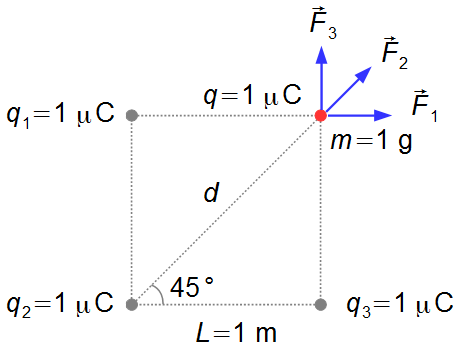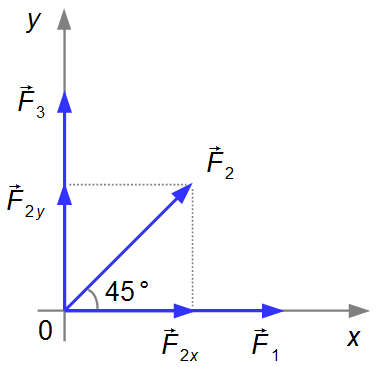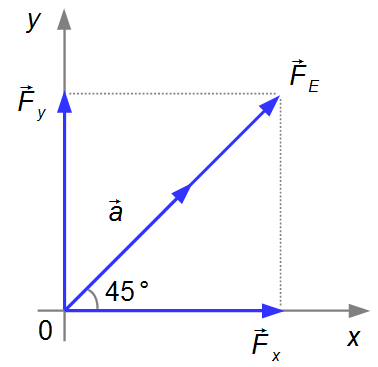Solved Problem on Coulomb's Law
advertisement
Three electric charges, of 1 μC each, are fixed at the vertices of a square of side 1 m, a particle with a charge of 1 μC and mass 1 g is left at rest at the fourth vertex of the square, at this moment begins to act a repulsive force of the other charges. Determine the acceleration of the particle at the moment it is released.
Problem data:
- Value of charges: q = 1 μC;
- Free charge mass: m = 1 g;
- Distance between charges: L = 1 m;
- Coulomb constant \( k_{0}=9\times10^{9}\;\frac{\mathrm{N.m}^{2}}{\mathrm{C}^{2}} \).
The electric force between two charges is in the direction of the line joining these charges, so
\( {\vec{F}}_{1} \)
is the electric force between charge q and charge q1,
\( {\vec{F}}_{2} \)
is the electric force between charge q and charge q2 and
\( {\vec{F}}_{3} \)
is the electric force between charge q and charge q3 (Figure 1).
The distance between charges q and q2 will be the diagonal d of the square, using the Pythagorean Theorem
The distance between charges q and q2 will be the diagonal d of the square, using the Pythagorean Theorem
\[
\begin{gather}
d^{2}=L^{2}+L^{2}\\[5pt]
d^{2}=1^{2}+1^{2}\\[5pt]
d^{2}=2\\[5pt]
d=\sqrt{2\;}\;\mathrm{m}
\end{gather}
\]

Solution
First, we convert the unit of mass given in grams to kilograms used in the International System of Units (SI).
\[
\begin{gather}
m=1\;\cancel{\mathrm{g}}\times\frac{1\;\mathrm{kg}}{1000\;\cancel{\mathrm{g}}}=\frac{1\;\mathrm{kg}}{10^{3}} =1\times10^{-3}\;\mathrm{kg}
\end{gather}
\]
According to Coulomb's Law, the electric force is given, in magnitude, by
\[
\begin{gather}
\bbox[#99CCFF,10px]
{F_{E}=k_{0}\frac{|Q_{1}||Q_{2}|}{r^{2}}} \tag{I}
\end{gather}
\]
We plot the forces on a Cartesian coordinate system and obtain their components along the x and
y directions (Figure 2).

- Direction x:
\[
\begin{gather}
F_{1x}=k_{0}\frac{q\;q_{1}}{L^{2}}\\[5pt]
F_{1x}=9\times 10^{9}\times\frac{1\times 10^{-6}\times1\times 10^{-6}}{1^{2}}\\[5pt]
F_{1x}=9\times 10^{9}\times 1\times 10^{-12}\\[5pt]
F_{1x}=9\times 10^{-3} \tag{II}
\end{gather}
\]
The x component of the force
\( {\vec{F}}_{2} \)
is given by
\[
\begin{gather}
F_{2x}=F_{2}\cos 45°
\end{gather}
\]
where F2 is given by the expression (I)
From the Trigonometry
\( \cos 45°=\dfrac{\sqrt{2\;}}{2} \)
\[
\begin{gather}
F_{2x}=k_{0}\frac{q\;q_{2}}{d^{2}}\cos 45°\\[5pt]
F_{2x}=9\times 10^{9}\times \frac{1\times 10^{-6}\times 1\times 10^{-6}}{(\sqrt{2\;})^{2}}\times \frac{\sqrt{2\;}}{2}\\[5pt]
F_{2x}=9\times 10^{9}\times \frac{1\times 10^{-12}}{2}\times \frac{\sqrt{2\;}}{2}\\[5pt]
F_{2x}=9\times 10^{-3}\times \frac{\sqrt{2\;}}{4} \tag{III}
\end{gather}
\]
The resultant of the forces along the x direction will be given by the sum of expressions (II)
and (III)
\[
\begin{gather}
F_{x}=F_{1x}+F_{2x}\\[5pt]
F_{x}=9\times 10^{-3}+9\times 10^{-3}\times \frac{\sqrt{2\;}}{4}\\[5pt]
F_{x}=9\times 10^{-3}\times \left(1+\frac{\sqrt{2\;}}{4}\right) \tag{IV}
\end{gather}
\]
- Direction y:
\[
\begin{gather}
F_{3y}=k_{0}\frac{q\;q_{3}}{L^{2}}\\[5pt]
F_{3y}=9\times 10^{9}\times \frac{1\times 10^{-6}\times 1\times 10^{-6}}{1^{2}}\\[5pt]
F_{3y}=9\times 10^{9}\times 1\times 10^{-12}\\[5pt]
F_{3y}=9\times 10^{-3} \tag{V}
\end{gather}
\]
The y component of the force
\( {\vec{F}}_{2} \)
is given by
\[
\begin{gather}
F_{2y}=F_{2}\sin 45°
\end{gather}
\]
where F2 is given by the expression (I)
From the Trigonometry
\( \sin 45°=\dfrac{\sqrt{2\;}}{2} \)
\[
\begin{gather}
F_{2y}=k_{0}\frac{q\;q_{2}}{d^{2}}\sin 45°\\[5pt]
F_{2y}=9\times 10^{9}\times \frac{1\times 10^{-6}\times 1\times 10^{-6}}{(\sqrt{2\;})^{2}}\times \frac{\sqrt{2\;}}{2}\\[5pt]
F_{2y}=9\times 10^{9}\times \frac{1\times 10^{-12}}{2}\times \frac{\sqrt{2\;}}{2}\\[5pt]
F_{2y}=9\times 10^{-3}\times \frac{\sqrt{2\;}}{4} \tag{VI}
\end{gather}
\]
The resultant of the forces along the y direction will be given by the sum of (V) and (VI)
\[
\begin{gather}
F_{y}=F_{3y}+F_{2y}\\[5pt]
F_{y}=9\times 10^{-3}+9\times 10^{-3}\times \frac{\sqrt{2\;}}{4}\\[5pt]
F_{y}=9\times 10^{-3}\times \left(1+\frac{\sqrt{2\;}}{4}\right) \tag{VII}
\end{gather}
\]
The magnitude of the resultant electric force FE will be obtained using the
Pythagorean Theorem using expressions (IV) and (VII)
\[
\begin{gather}
F_{E}^{2}=F_{x}^{2}+F_{y}^{2}\\[5pt]
F_{E}^{2}=\left[9\times 10^{-3}\times \left(1+\frac{\sqrt{2\;}}{4}\right)\right]^{2}+\left[9\times 10^{-3}\times \left(1+\frac{\sqrt{2\;}}{4}\right)\right]^{2}\\[5pt]
F_{E}^{2}=2\times \left[9\times 10^{-3}\times \left(1+\frac{\sqrt{2\;}}{4}\right)\right]^{2}\\[5pt]
F_{E}=\sqrt{2\times \left[9\times 10^{-3}\times \left(1+\frac{\sqrt{2\;}}{4}\right)\right]^{2}\;}\\[5pt]
F_{E}=9\times 10^{-3}\times \left(1+\frac{\sqrt{2\;}}{4}\right)\times \sqrt{2\;}\\[5pt]
F_{E}=9\times 10^{-3}\times \left(\sqrt{2\;}+\frac{\sqrt{2\;}\times \sqrt{2\;}}{4}\right)\\[5pt]
F_{E}=9\times 10^{-3}\times \left(\sqrt{2\;}+\frac{2}{4}\right)\\[5pt]
F_{E}=9\times 10^{-3}\times \left(\sqrt{2\;}+\frac{1}{2}\right)\\[5pt]
F_{E}=1.72\times 10^{-2}\;\mathrm{N}
\end{gather}
\]
Using Newton's Second Law
\[
\begin{gather}
\bbox[#99CCFF,10px]
{\vec{F}=m\vec{a}}
\end{gather}
\]
the only force acting on the charge is the electric force FE, so the acceleration will
be in the same direction as the resultant electric force

\[
\begin{gather}
F_{E}=ma\\[5pt]
a=\frac{F_{E}}{m}\\[5pt]
a=\frac{1.72\times 10^{-2}}{1\times 10^{-3}}\\[5pt]
a=1.72\times 10^{-2}\times 10^{3}\\[5pt]
a=1.72\times 10
\end{gather}
\]
\[
\begin{gather}
\bbox[#FFCCCC,10px]
{a=17.2\;\mathrm{m/s}^{2}}
\end{gather}
\]
advertisement

Fisicaexe - Physics Solved Problems by Elcio Brandani Mondadori is licensed under a Creative Commons Attribution-NonCommercial-ShareAlike 4.0 International License .